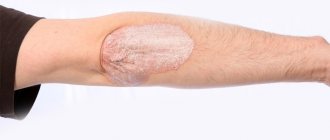Pharmacological properties of the drug Penicillamine
Penicillamine is an amino acid containing an additional SH group. The compound belongs to the class of stable non-physiological amino acids and is a structural component of the penicillin molecule, from which it is obtained by hydrolysis. Penicillamine does not have antibacterial properties, but is capable of forming non-toxic water-soluble chelates with heavy metals (copper, gold, lead, mercury, cobalt and zinc), which are then excreted from the body in the urine. Penicillamine has the ability to convert slightly soluble cystine into more soluble cysteine disulfide, which is excreted from the body mainly by the kidneys. Due to the presence of a stable sulfhydryl group, penicillamine has the ability to decompose disulfide bonds of high molecular weight immune complexes (macroglobulins). Penicillamine helps increase the amount of collagen soluble in neutral salts and (partially) collagen soluble in acids. In addition, penicillamine simultaneously reduces the level of insoluble collagen. Penicillamine inhibits the cellular (T-lymphocytes) and humoral (B-lymphocytes, plasma cells) immune response. It has been experimentally established that penicillamine has an antiviral effect (against the polio virus). Penicillamine is a basic agent in the treatment of rheumatoid arthritis. With long-term use (over several weeks or months) it causes clinical improvement and reduces the elevated titer of rheumatoid factor.
Use of the drug Penicillamine
Inside, preferably on an empty stomach, with water. You should refrain from eating for 1.5 hours before and after taking penicillamine. For rheumatoid arthritis, chronic inflammatory liver diseases, scleroderma, the following is prescribed: during the first 4 weeks - 150 mg/day (up to 250 mg/day); over the next 4 weeks - 250 mg/day (up to 450 mg/day); over the next 4 weeks - 2 times 150 mg/day (up to 600 mg/day); the dose is increased by 50–150 mg/day at 4–12-week intervals to 750 mg/day. In some cases, a maximum dose of 1000 mg/day may be required. When clinical improvement is achieved, the dose is gradually (by 50–100 mg) reduced to the minimum effective. As a rule, the maintenance dose is 300–450 mg/day. For juvenile rheumatoid arthritis, patients weighing less than 20 kg are prescribed 50 mg/day, and patients weighing more than 20 kg are prescribed 100 mg/day. The dose is gradually increased (by 50 mg at 2-4 week intervals), but not exceeding 15-20 mg/kg or 600 mg/day. When a therapeutic effect is achieved, they switch to maintenance treatment at a dose of 100–250 mg/day. For Wilson's disease, the dose is determined depending on the severity of the disease and the amount of copper determined in the urine. For adults, the dose is gradually increased from 250 to 1000 mg/day; the maximum dose is 2000 mg/day, the maintenance dose is 750–1000 mg/day. Children are prescribed in gradually increasing doses from 150 to 750 mg/day. For cystinuria, it is prescribed at the rate of 1000 mg per 1 m2 of body surface. For poisoning with heavy metal salts, adults are prescribed from 0.9 to 1.8 g/day; The duration of therapy is determined taking into account the amount of heavy metal salts in the urine. At the same time, replacement therapy with vitamin B6 is prescribed - at least 40 mg/day orally.
Penicillamine
Orally, on an empty stomach (do not eat 1.5 hours before or after administration).
For Wilson-Konovalov disease, adults are prescribed an initial dose of the drug of 250 mg, gradually increasing to 0.75-1.5 g/day. The dose is considered effective if the daily excretion of Cu2+ in urine (after 1 week of treatment) exceeds 2 mg. Subsequently, the adequacy of the dose is determined based on measuring the content of free Cu2+ in the blood serum (it should be less than 10 μg/ml). In some cases, the daily dose is 2 g or more.
For cystinuria, adults - 1-4 g/day (on average - 2 g/day), children - at the rate of 300 mg/kg/day. The daily dose is divided into 4 doses, a larger single dose is prescribed on an empty stomach. The dose is selected individually, based on determining the excretion of cysteine in the urine (the optimal dose is considered to be not exceeding 100-200 mg/day in patients with no signs of nephrourolithiasis and less than 100 mg/day in patients with nephrourolithiasis). During treatment, you need to drink plenty of fluids, it is especially important to take an additional amount of fluid (at least 0.5 l) immediately before bed and at night.
For rheumatoid arthritis, chronic hepatitis, scleroderma, the initial dose is 125-250 mg/day (the first 4 weeks). Then, if well tolerated, the dose of the drug is increased by 125 mg every 1-2 months. The first signs of a therapeutic effect are observed no earlier than 3 months of continuous use. If by this time there is no therapeutic effect, subject to good tolerance, the dose is gradually increased (by 125 mg every 1-2 months). If there is no therapeutic effect after 6 months of therapy, the drug is discontinued. When a satisfactory effect is achieved, continuous administration at the same dose is continued for a long time. In rheumatoid arthritis, the clinical effect of therapy with small (250-500 mg/day) and large (750 mg/day or more) doses of the drug is usually the same.
For juvenile rheumatoid arthritis, the initial dose for body weight less than 20 kg is 50 mg / day, over 20 kg - 100 mg / day in 2 doses; increase the dose by 50 mg/day at 2-4 week intervals to 15-20 mg/kg or 600 mg/day.
For alcoholic cirrhosis of the liver - 250 mg or 125 mg after dinner, achieving a gradual reduction in liver size, without aggravating cytolysis (increased activity of “liver” transaminases). Prescribed on an empty stomach, no less than 1 hour before or 2 hours after a meal, and no earlier than 1 hour after taking any other drugs.
For poisoning - 0.9-1.8 g/day.
Side effects of the drug Penicillamine
Possible feeling of heaviness in the stomach, anorexia, nausea, fever, arthralgia, lymphadenopathy, allergic reactions (itching, rash, urticaria, Quincke's edema), stomatitis, gingivitis, glossitis; rarely - leukopenia, thrombocytopenia, agranulocytosis, aplastic anemia, eosinophilia, proteinuria, glomerulonephritis, nephrotic syndrome, systemic lupus erythematosus, pemphigus vulgaris, seborrheic pemphigus, pemphigoid, latent antinuclear antibody syndrome (the appearance of antinuclear antibodies, as well as an increase in the titer of antinuclear antibodies); extremely rarely - cholestatic syndrome, myasthenia gravis, peripheral neuropathy, exfoliative dermatitis, Goodpasture's syndrome, polymyositis, dermatomyositis, alopecia.
Special instructions for the use of the drug Penicillamine
Before starting and during treatment with penicillamine (every 2–4 weeks), blood composition tests are performed. If the leukocyte count in the peripheral blood is below 4000 per 1 mm3, and the platelet count is below 100,000 per 1 mm3, penicillamine should be discontinued. If eosinophilia develops, reduce the dose or temporarily stop taking penicillamine. Urinalysis is performed weekly or every 2 weeks, and when maintenance treatment is prescribed - every 4 weeks. If proteinuria is high (up to 1 g/l in daily urine), penicillamine should be discontinued. Every 4 weeks, the level of transaminases and alkaline phosphatase in the blood plasma is determined; antinuclear antibodies - every 3 months (careful monitoring of patients who have elevated titers of antinuclear antibodies is required). If antinuclear antibodies are detected during treatment, as well as if the titer of antinuclear antibodies exceeds 1:80, penicillamine should be discontinued immediately. When treating children, laboratory tests should be performed more often. Penicillamine should not be prescribed if antibiotics are necessary due to any concomitant disease. If a skin rash appears, antihistamines or corticosteroids should be prescribed in high doses. If taste disturbances occur or side effects from the digestive system develop, the dose should be reduced or temporarily discontinued penicillamine. If cryotherapy is canceled due to its ineffectiveness, penicillamine can be prescribed no earlier than 6 weeks after discontinuation of gold preparations. If cryotherapy is canceled due to intolerance, penicillamine can be prescribed only when the side effects caused by taking gold preparations disappear. When prescribing penicillamine to patients with impaired renal function, appropriate dose adjustment is necessary. In case of Wilson's disease, penicillamine should be continued during pregnancy (in minimally effective doses); in all other cases, taking penicillamine during pregnancy should be discontinued or, if necessary, replaced with symptomatic therapy.
Treatment of rheumatoid arthritis
Treatment methods for rheumatoid arthritis: basic therapy, anti-inflammatory drugs of different groups, methods of physical and mechanical influence on the immune system, local treatment, physiotherapeutic treatment, diet.
The main treatment for rheumatoid arthritis is the so-called basic drugs. Therefore, it is with basic drugs that we will begin our conversation about methods of treating arthritis. It is believed that basic drugs act on the basis of the disease, its “basis”. These drugs are used with an eye to the future, counting on their ability to interrupt the development of the disease. But you need to keep in mind that, unlike anti-inflammatory drugs and hormones, basic drugs do not provide an immediate positive effect, that is, they do not eliminate the symptoms of the disease in the first days and weeks of their use. As a rule, basic drugs can take effect no sooner than after a month - and this is their significant drawback.
In addition, practically no basic drug is capable of providing a guaranteed 100% result. That is, many of the basic drugs slow down the development of arthritis and provide improvement over time, but how pronounced this improvement will be cannot be predicted in advance by even the most experienced rheumatologist. Therefore, the correct selection of basic therapy largely depends not only on the doctor’s experience, but also on his intuition. Nevertheless, any basic drug has its own characteristic advantages and disadvantages, and we will now talk about them.
Basic therapy for rheumatoid arthritis
Currently, three groups of drugs are most often used as basic therapy: gold salts, antimalarial drugs, and the antimicrobial drug sulfasalazine.
Cytostatics (immunosuppressants).
Cytostatic drugs, or so-called immunosuppressants (methotrexate, Arava, Remicade, azathioprine, cyclophosphamide, chlorbutin, cyclosporine, and others), were borrowed by rheumatologists from oncologists. According to most modern rheumatologists, cytostatics are the best group of basic drugs for the treatment of not only rheumatoid, but also psoriatic arthritis.
In oncology, these drugs are used to inhibit cell division, including cancer cells. Moreover, cytostatics are prescribed to cancer patients in huge doses, which leads to a large number of complications. In this regard, both doctors and patients are very wary of the use of cytostatics, fearing severe side effects.
However, when it comes to the use of these drugs in the treatment of arthritis, the danger is clearly exaggerated, because in arthrology, cytostatics are used in significantly lower doses than in oncology. Doses of cytostatics in the treatment of arthritis are approximately 5-20 times less than the doses used in the treatment of tumors!
Such small amounts of immunosuppressive drugs rarely cause side effects, but the therapeutic effect is often significant. The use of cytostatics helps at least 70-80% of patients, and the drugs bring the greatest benefit to those suffering from a rapidly progressing severe form of rheumatoid arthritis.
Side effects are possible in 15-20% of patients and are rarely severe. Most often these are allergic rashes, a sensation of “goosebumps” on the skin, stool upset and moderate urination problems. All these manifestations usually disappear immediately after stopping the drugs. Other side effects, which can be learned from the drug leaflet, occur infrequently when taking “anti-arthritic doses” of cytostatics.
However, in order to avoid complications, it is necessary to monitor the condition of the patient taking immunosuppressants. Once a month you need to examine your urine, and most importantly, do a blood test taken from your finger once every two weeks in order to notice in time a possible inhibition of hematopoiesis. Once every three months it is necessary to check “liver parameters” in blood taken from a vein. If everything is in order and the patient easily tolerates cytostatic therapy, you can expect a clear improvement in well-being within 2–4 weeks after the start of treatment.
Currently, rheumatologists most often use 3 cytostatic drugs to treat rheumatoid arthritis:
Methotrexate is perhaps the best of the best basic drugs for the treatment of rheumatoid and psoriatic arthritis. Today it is considered the “drug of choice” for these diseases. For the basic treatment of rheumatoid arthritis, methotrexate is taken only once (10-20 mg) per week.
For the first time, a specific day is chosen, say, Monday, and from then on, throughout the entire course of treatment, methotrexate is taken only on Mondays. The therapeutic effect usually appears within 5-6 weeks from the start of taking methotrexate and usually reaches its maximum within six months to a year.
Attention! On the day of taking methotrexate, it is advisable to avoid using non-steroidal anti-inflammatory drugs. On all other days, anti-inflammatory drugs can be used safely.
Arava , or leflunomide. Arava is considered to be as effective and tolerable as methotrexate and sulfasalazine. Although, according to my observations, it is still tolerated somewhat worse than methotrexate.
In general, Arava is recommended for patients whose arthritis is very active and for those who do not tolerate methotrexate well. And arava is sometimes prescribed to those patients for whom methotrexate helps little - since it happens that sometimes arava helps patients for whom methotrexate was ineffective (and vice versa, it often happens that methotrexate helps a patient well, but arava does not).
The therapeutic effect usually appears 4-6 weeks from the start of taking Arava and can increase over 4-6 months.
Remicade , also known as infliximab , and drugs with similar effects. A new fast-acting and quite effective basic drug.
It is used in cases where other basic drugs, in particular methotrexate, do not provide the desired effect. Remicade is also used in cases where it is necessary to reduce the dose of corticosteroid hormones taken, or when arthritis is very active.
Unfortunately, Remicade is still very expensive. However, despite the high cost, the use of Remicade is slowly gaining momentum - due to the fact that Remicade acts faster than many other basic drugs.
However, Remicade must be used with great caution. Very often, it is more difficult for patients to tolerate than Arava or methotrexate, and more often produces side effects.
Before starting treatment with Remicade, it is necessary to identify and treat all the patient's infections, including hidden ones, and treat all abscesses. After all, if this is not done, the use of Remicade can provoke a severe exacerbation of untreated infectious processes, up to the development of sepsis.
In addition, during treatment with Remicade, it is recommended to use antiallergic drugs to prevent possible allergic reactions (they happen quite often).
Even during treatment, it is necessary to use reliable methods of contraception in order to prevent pregnancy - Remicade is strictly contraindicated for pregnant women and nursing mothers (you should refrain from breastfeeding during therapy). Breastfeeding is allowed no earlier than 6 months after the end of Remicade treatment!
* * *
Other cytostatic drugs, such as azathioprine (Imuran), chlorobutin, cyclophosphamide (Endoxan) and cyclosporine (Imusporin, Consupren, Sandimmune, Ecoral), are rarely used for rheumatoid arthritis, since they are much more difficult to tolerate by patients than methotrexate, Arava and Remicade and much more often give various side effects. Due to the “severity” of the listed drugs, their poor tolerability and high frequency of side effects, these drugs are used only in extreme cases, when other basic drugs are ineffective.
Antimalarial drugs (delagil and plaquenil).
The antimalarial drugs delagil (also known as chloroquine, resoquine, hingamine) and plaquenil (also known as hydroxychloroquine, hydrochlorine) have long been used by infectious disease specialists to treat tropical fever (malaria).
However, in the 20th century. Rheumatologists also paid attention to them. They noticed that with very long-term use, delagil and plaquenil are able to influence the activity of the rheumatoid process, gradually reducing inflammation in the joints.
Unfortunately, over time it turned out that these drugs act very slowly: the therapeutic effect develops only after six months to a year of continuous use of the medicine. The effectiveness of delagil and plaquenil also turned out to be low. These are among the weakest of all modern basic drugs.
But they have an important advantage - good tolerability and a small number of side effects.
Although the effectiveness of these drugs is not very high and they act slowly, we are forced to use them to this day, since we feel a relative shortage of anti-rheumatoid drugs.
After all, sometimes situations arise when other basic remedies are tried unsuccessfully and canceled due to ineffectiveness or severe side effects. Then it is necessary to use delagil and plaquenil, which are weak but still have a specific anti-arthritic effect.
According to most leading modern rheumatologists, basic therapy should be started with antimalarials only when rheumatoid arthritis is very mild, and there is no need for stronger drugs that have a better therapeutic effect, but can provoke numerous side effects.
Indeed, unlike them, antimalarial drugs are practically harmless. Only in rare cases, with long-term use, delagil or plaquenil can provoke the development of adverse reactions.
Sulfonamides (sulfasalazine and salazopyridazine).
Sulfasalazine and salazopyridazine are antimicrobial drugs successfully used in the basic therapy of rheumatoid arthritis. In terms of the potency of the therapeutic effect, sulfonamides are quite slightly inferior to the drugs gold and methotrexate, quite comparable in effectiveness to D-penicillamine, and clearly superior in potency to drugs such as delagil and plaquenil.
The main advantage of sulfonamides over other basic drugs is their good tolerability - sulfasalazine and salazopyridazine have almost no complications even with long-term use.
With long-term use, side effects develop in only 10-20% of patients, and these side effects are almost never severe.
The only thing that detracts from the advantages of sulfonamide drugs is the slow development of their therapeutic effect. Some improvement in the condition during treatment with sulfonamides is usually observed only after three months of therapy, and the “peak form” is reached 6-12 months after the start of treatment.
* * *
So, there are 3 main groups of basic drugs to combat rheumatoid arthritis. They all have their advantages, and, unfortunately, their disadvantages, which we have just discussed. The most common question that patients ask about basic therapy and which is often discussed by patients on the Internet concerns the potential harm of basic drugs.
Thus, one of the amateur “specialists”, who clearly does not understand the problem, stated with indignation on one of the Internet forums: “What kind of medicines do doctors prescribe if they have so many side effects - they cure one thing, and cripple another?”
Indeed, how great is the desire of some narrow-minded people to see in everything almost a conspiracy of doctors. But maybe they are right, and we really don’t need to prescribe the patient any medications in general, and basic drugs in particular? Let him get sick and suffer?
If we discard the idle speculations of narrow-minded critics, the facts look like this: according to numerous observations of scientists and doctors (and according to my observations too), the later a patient is prescribed basic therapy, the worse it is for him - the disease is much more severe, with numerous complications, and more often ends in fatal outcome. And vice versa, if basic drugs are prescribed to the patient on time, in the first months of the disease, we are often able to achieve a significant improvement in the patient’s well-being, and sometimes it is even possible to completely interrupt the development of the disease.
Although, of course, the selection of basic therapy is a serious matter. And we must take into account the possibility of side effects. Therefore, the attending physician, as they say, must constantly keep his “finger on the pulse” and regularly monitor the patient’s condition.
It is also advisable that the patient be as informed as possible about what complications the medication taken may cause, and inform the doctor about any alarming reactions. It was with the goal of giving you maximum information about the medications you are taking and their possible adverse reactions that I wrote this chapter.
But still: which basic drug should be preferred in each specific case? Only your treating rheumatologist can answer this question. Only he knows (in any case, he should know) when and what basic remedy should be used for a particular patient.
Although the disadvantage of basic drugs is precisely that it is difficult for doctors to predict with 100% certainty whether the medicine will give the desired therapeutic effect. The answer to this question can be obtained only after a month or two from the start of using the drug. And if the drug does not work, then you have to change it and again wait a couple of months for the result.
Thus, it sometimes takes from 4 to 6 months to select basic therapy. The period is, of course, extremely long for a sick person, but we have to accept it - we have no other choice. But we can try to improve the patient's condition during this "waiting period" using methods of physical and mechanical influence on the immune system, using anti-inflammatory drugs, and using local effects on the joints. We will talk about them further.
Anti-inflammatory drugs of different groups
1. Non-steroidal anti-inflammatory drugs (NSAIDs).
As a first aid remedy for joint pain, “classical” non-steroidal anti-inflammatory drugs are most often used - diclofenac, ibuprofen, ketoprofen, piroxicam, indomethacin, movalis, butadione, etc. Non-steroidal anti-inflammatory drugs for rheumatoid arthritis effectively reduce inflammation in the joints and reduce pain.
Without a doubt, these drugs can significantly make the patient’s life easier, but it is impossible to cure rheumatoid arthritis with non-steroidal anti-inflammatory drugs. They are not used to cure arthritis, but to temporarily reduce inflammation and pain in the joint.
That is, they cannot stop the development of the disease, but are used exclusively symptomatically. And as soon as the patient stops taking them, the disease gradually returns.
However, since it is very difficult for a person suffering from rheumatoid arthritis to do without non-steroidal anti-inflammatory drugs, and it takes a long time to take NSAIDs for arthritis, let's talk about how best to use them.
Treatment should begin with the least toxic drugs. That is, those that are quickly absorbed and easily excreted from the body. Such drugs include diclofenac, ibuprofen, ketoprofen and their derivatives, as well as the selective anti-inflammatory drug movalis.
Indomethacin, piroxicam, ketorolac and their analogues take longer to be eliminated from the body and are considered more “heavy” drugs, so they try to prescribe them less frequently, mainly to those patients who have a lower risk of developing side effects from the kidneys, cardiovascular system and stomach. In addition, given that indomethacin can cause the development of mental disorders in older people, it is prescribed, as a rule, only to young or middle-aged patients.
The second selection criterion is the effectiveness of the drug. Typically, the therapeutic effect from the use of non-steroidal anti-inflammatory drugs develops quickly, during the first three to seven days of treatment. If during this time there is no improvement from taking the anti-inflammatory drug used, it must be changed to another.
At the same time, diclofenac is considered one of the most effective anti-inflammatory drugs. True, many patients, and even doctors, are put off by the overly detailed summary of the drug. Especially the part where all possible complications and side effects to the medicine are punctually listed. Most people who read the summary think that they will definitely experience all of the listed complications.
Meanwhile, diclofenac is no more harmful than aspirin, which many people drink without thinking about it. It’s just that the summary for diclofenac is written more honestly and in more detail. But the listed side effects do not occur in all people, even for years taking diclofenac or its analogues.
2. Corticosteroid hormonal drugs (corticosteroids).
To provide quick help to those suffering from rheumatoid arthritis, many doctors, especially foreign ones, in addition to non-steroidal anti-inflammatory drugs, do not hesitate to prescribe anti-inflammatory corticosteroid hormones: prednisolone (aka Medopred), triamcinolol (aka Kenalog, Polcortolone, triamsinolol, Kenacort), dexamethasone, methylprednisolone (aka aka metypred, medrol, depo-medrol), betamethasone (aka diprospan, flosteron, celeston).
Among our doctors, there are two polarly different views on the use of hormonal corticosteroid drugs. Some doctors clearly welcome their use for medicinal purposes, while others completely reject and ignore them. As a result, patients who try to keep up with the trends of “medical fashion” are completely perplexed: are such hormones useful for arthritis or harmful, can they be used or not? Well, let's think together.
On the one hand, the use of such hormones almost always leads to a clear improvement in the patient’s condition. Joint pain immediately decreases, morning stiffness disappears, weakness and chills disappear or decrease. Naturally, such a quick result makes any patient feel grateful to the doctor. And in the conditions of paid medicine, this gratitude is often supported financially - for such relief the patient is willing to pay money, considerable money at that - which is the main incentive for Western and modern paid medicine.
Unfortunately, patients taking corticosteroid hormones are often unaware that they are receiving a fairly powerful blow to all body systems. After all, corticosteroids are stress hormones. And as long as the patient takes such hormones, he feels good. But as soon as they are canceled or the dose is reduced, the disease will literally attack the person with double or triple force.
You may ask: maybe then it’s worth not canceling hormones, but continuing to take them constantly? No, this is not an option. The fact that over time corticosteroids no longer relieve pain as well as at the beginning of their use is not so bad. The worst thing is that the side effects from their use gradually “accumulate”.
There are many such side effects - corticosteroids contribute to the development of the Itsenko-Cushing symptom complex, in which sodium and water are retained in the body with the possible appearance of edema and increased blood pressure. In addition, such hormones increase blood sugar levels leading to the development of diabetes, promote weight gain, reduce immunity, provoke stomach and duodenal ulcers in some patients, and increase the risk of blood clots.
With long-term use of corticosteroids, acne, a moon-shaped face, menstrual irregularities, and the development of hemorrhagic pancreatitis may occur. Some patients develop reactions from the nervous system: insomnia, euphoria, agitation (in some cases even with the development of psychosis), and seizures similar to epilepsy. In addition, with long-term use, medicinal corticosteroids suppress the body's production of its natural hormones.
As a result, sooner or later there comes a time when, due to side effects, the patient is forced to stop taking corticosteroid hormones. But this is not so easy to do. The body can no longer cope without the supply of corticosteroids from the outside, and a rapid reduction in their dose leads to a sharp deterioration in well-being and exacerbation of joint pain.
Therefore, the dose of hormones consumed must be reduced gradually, a few milligrams per week. And their final cancellation is delayed for several months. But even with such a gradual reduction in the dose of hormones, the process is rarely painless for the body.
So, before prescribing hormone therapy to a patient, the doctor must weigh three times whether such treatment will cause more harm or benefit. From my point of view, hormones should be prescribed only when arthritis is highly active, when inflammatory indicators are “off the charts” (for example, an increase in ESR, or ROE, above 40 mm/hour, with a strong increase in the levels of C-reactive protein, seromucoid and other indicators ), especially if the inflammation is not controlled by non-steroidal anti-inflammatory drugs, and is accompanied by severe pain and weakness of the patient.
So, before prescribing hormone therapy to a patient, the doctor must weigh three times whether such treatment will cause more harm or benefit. From my point of view, hormones should be prescribed only when arthritis is highly active, when inflammatory indicators are “off the charts” (for example, an increase in ESR, or ROE, above 40 mm/hour, with a strong increase in the levels of C-reactive protein, seromucoid and other indicators ), especially if the inflammation is not controlled by non-steroidal anti-inflammatory drugs, and is accompanied by severe pain and weakness of the patient.
And, of course, hormones should definitely be prescribed for the development of a number of so-called systemic complications of arthritis - Felty's syndrome, Still's syndrome, polymyalgia rheumatica, etc. That is, on the one hand, the doctor does not have the right to prescribe hormones to everyone, but he should not refuse their use in cases where they are really needed.
Indeed, in some situations, the use of hormones can, without exaggeration, save the patient’s life. Therefore, the issue of their use must be approached very carefully, and, naturally, it is also necessary to take into account the presence of contraindications to hormonal treatment.
Local treatment
1. Intra-articular injection of corticosteroid hormones
Most often, drugs of corticosteroid hormones are injected into the joint for arthritis: Kenalog, Diprospan, hydrocortisone, Flosterone, Celeston, Metypred, Depo-Medrol. Corticosteroids are good because they quickly and effectively suppress pain and inflammation due to swelling and swelling of the joint. It is the speed with which the therapeutic effect is achieved that is the reason why corticosteroid injections have gained particular popularity among doctors.
The introduction of corticosteroid hormones into the joint helps the patient survive a period of particularly acute inflammation of individual joints. Such intra-articular injections can significantly make life easier for the patient, even in particularly severe cases of rheumatoid arthritis. But usually the therapeutic effect of the injection lasts only 3-4 weeks. Then the inflammation begins to gradually increase again.
That is, such injections are in no way a panacea. Moreover, they cannot be done too often - otherwise the hormones will begin to have a negative effect on the entire body.
Therefore, the intervals between such procedures should be at least 7-10 days. And in total, it is undesirable to give more than 5-8 hormonal injections to one joint, even at large intervals. After all, too frequent administration of hormones provokes disruption of the structure of the joint ligaments and surrounding muscles, gradually causing “looseness” of the joint and destruction of cartilage.
2. Laser therapy
This method has a mild anti-inflammatory effect for rheumatoid arthritis. Laser therapy is used both as a separate method of treating rheumatoid arthritis and in combination with basic therapy.
There are two ways to influence a patient’s body with laser radiation. In the acute phase of rheumatoid arthritis, the laser does not irradiate the patient’s joints, but the area of the cubital vein - that is, the radiation affects the blood circulating inside the body. It is believed that after irradiating blood with a laser, various positive changes occur in the body: immunity is normalized, blood supply to organs and tissues is improved, any inflammation is reduced and foci of infection are suppressed.
In the chronic phase of the disease (when blood tests and body temperature are normal), the laser is applied directly to the joints of a patient with rheumatoid arthritis. This is done provided that the patient has normal tests and body temperature. Improvement after laser therapy is observed in 80% of patients, although at the beginning of the course of treatment there is a short-term exacerbation of the disease.
In general, the most favorable results are observed in patients with a sluggish, mild form of rheumatoid arthritis. In severe forms of the disease, laser is ineffective. The course of treatment consists of 15-20 procedures performed every other day.
Contraindications to the use of laser are tumor diseases, blood diseases, hyperfunction of the thyroid gland, infectious diseases, physical exhaustion, bleeding, myocardial infarction, stroke, tuberculosis, cirrhosis of the liver, hypertensive crisis.
3. Cryotherapy - exposure to local cooling
Cryotherapy is one of the best local methods of treating rheumatoid, psoriatic and reactive arthritis, as well as ankylosing spondylitis. Cryotherapy has been successfully used in both the acute and chronic phases of rheumatoid arthritis. This treatment is practically harmless and has almost no contraindications, but requires regularity. Improvement after cryotherapy is observed in more than 80% of patients with rheumatoid arthritis.
There are two main hardware methods of cryotherapy: dry cryotherapy (exposure to ultra-low temperature air, in particular the use of cryosaunas), and “liquid cryotherapy” - exposure of the body to a jet of liquid nitrogen.
With “liquid cryotherapy,” a pressurized stream of liquid nitrogen is directed onto the affected joints or back; the nitrogen instantly evaporates and quickly cools the affected area. As a result of this procedure, it is possible to achieve a pronounced response from the body and the affected joints - inflammation and swelling of the joints are reduced, blood circulation and metabolism are improved, and pain is reduced. The course of treatment includes 8-12 procedures performed daily or every other day.
When used correctly, cryotherapy with liquid nitrogen has almost no contraindications and can be used even to treat elderly, debilitated patients. It cannot be used only for Raynaud's syndrome, some arrhythmias, and immediately immediately after a heart attack or stroke.
During dry cryotherapy, the undressed patient is placed for a very short time in a special room - a cryosauna, where very cold air is supplied. Dry cryotherapy has a lesser local effect on individual inflamed joints of the patient, but, like liquid cryotherapy, it has a good effect on the general condition of patients with rheumatoid arthritis - especially when the patient has a large group of joints inflamed at once.
However, other things being equal, dry cryotherapy in commercial medical centers usually costs much more than liquid cryotherapy, since it requires more complex and expensive equipment.
4. Healing ointments and creams
Medicinal ointments and creams are often advertised as guaranteeing cure for joint diseases. However, for arthritis, medicinal ointments can bring only slight relief to the patient.
Usually, for rheumatoid arthritis, ointments based on non-steroidal anti-inflammatory substances (indomethacin, butadione, dollit, voltaren-gel, fastum-gel, etc.) are used. Unfortunately, they do not act as effectively as we would like - after all, the skin allows no more than 5-7% of the active substance to pass through, and this is clearly not enough to develop a full anti-inflammatory effect.
But these ointments almost never cause the side effects that occur from the internal use of non-steroidal anti-inflammatory drugs. That is, they are practically harmless.
Physiotherapeutic treatment of rheumatoid arthritis
Massage and any physiotherapeutic procedures, with the exception of cryotherapy and laser, for rheumatoid arthritis are carried out only when the exacerbation of arthritis has passed and blood counts return to normal. After all, physiotherapy and massage have a stimulating effect on the body, which is useful for arthrosis, but with arthritis it can increase inflammation of the joints.
Therefore, physiotherapy and massage are done exclusively when the body temperature is normal, blood tests are good and in the absence of redness and swelling of the joints (redness and swelling indicate the accumulation of pathological “inflammatory” fluid in the joint).
Let me emphasize once again: massage and almost any physiotherapeutic procedures, with the exception of cryotherapy and laser, are absolutely contraindicated in cases of moderate and high activity of rheumatoid arthritis, while noticeable inflammation of the joints continues!
And only after the exacerbation has been eliminated, you can move on to gentle massage and physiotherapy in order to improve blood circulation in diseased joints, reduce their deformation and increase their mobility.
For this purpose, infrared irradiation, diathermy, UHF, paraffin, ozokerite and therapeutic mud applications are used. These types of physiotherapy promote muscle relaxation and eliminate joint contractures, and improve nutrition for diseased joints. Phonophoresis with medications (for example, hydrocortisone) has also been successfully used. Phonophoresis has a mild anti-inflammatory effect on the patient’s joints.
X-ray therapy is used somewhat less frequently for rheumatoid arthritis. The method involves exposing the affected joints to small doses of x-rays. Small doses of radiation have a pronounced analgesic and anti-inflammatory effect and do not cause serious complications. Sometimes radiotherapy is used to enhance the anti-inflammatory effect of basic drugs, even with active rheumatoid arthritis.
Diet for rheumatoid arthritis
Diet for rheumatoid arthritis is one of the important components of treatment. In some patients, there is a clear relationship between the activity of inflammation and the tolerance of certain foods.
Exacerbation of arthritis occurs when eating foods that “allergize” the body, and their abolition leads to an improvement in the condition. Most often, according to some scientists, the exacerbation of the inflammatory process in rheumatoid arthritis is facilitated by eating corn, wheat, pork, citrus fruits, oatmeal, rye, milk and dairy products.
This means that all these foods should be limited or excluded, if possible, from the diet of a patient with rheumatoid arthritis. It is recommended to consume fish, fish oil and other seafood, as well as vegetables, fruits, chicken eggs, pearl barley and buckwheat. Meals should be small and frequent, 5-6 times a day.
It is advisable to steam food. Try to reduce your salt intake and eat fried or smoked foods as little as possible. Some scientists recommend that patients suffering from rheumatoid arthritis generally switch to diet No. 10 (see Chapter 1).
***
Article by Dr. Evdokimenko© for the book “Arthritis”, published in 2003. Edited in 2011 All rights reserved.
READ MORE:
- Symptoms of rheumatoid arthritis
- Causes of rheumatoid arthritis
- Diagnosis of rheumatoid arthritis
- No more medications needed?
- All articles by Dr. Evdokimenko









